
GEOMETRY: TWO- AND THREE-DIMENSIONAL SHAPES
 |
Unit Overview
Two-dimensional figures have been taught in previous years. This lesson will review those shapes. You will also learn about three-dimensional figures and their characteristics. Then, you will take these three-dimensional figures and will slice them in sections to make two dimensional figures. You will be asked to name the two-dimensional figure formed by these cross sections.
What are two-dimensional shapes?
In geometry, a two-dimensional shape can be defined as a flat, plane figure or a shape that has two dimensions – length and width. Two-dimensional, or 2-D, shapes do not have any thickness.
We can classify figures on the basis of the dimensions they have.
A circle, triangle, square, rectangle and pentagon are examples of two-dimensional shapes.
 |
What are three-dimensional shapes?
In geometry, a three-dimensional shape can be defined as a figure or an object that has three dimensions – length, width and height. Unlike two-dimensional shapes, three-dimensional shapes have thickness or depth.
The attributes of a three-dimensional figure are faces, edges and vertices. The three dimensions make a 3D, geometric shape.
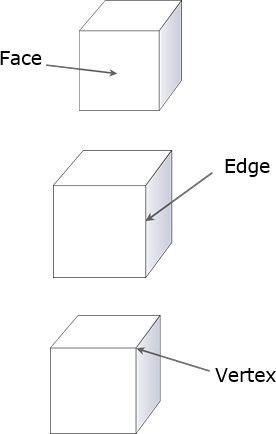 |
A cube, rectangular prism, sphere, cone, and cylinder are the basic 3-dimensional shapes we see around us.
The bases of 3-dimensional shapes are the surface the solid object can stand on. In some 3-dimensional shapes, there are two bases which are opposite faces that are parallel and congruent.
Lateral faces of 3-dimensional shapes are the side faces, not the bases.
 |
We can see a cube in a Rubik’s cube and a die; a rectangular prism in a book and a box; a sphere in a globe and a ball; a cone in a carrot and an ice cream cone; and a cylinder in a bucket and a barrel.
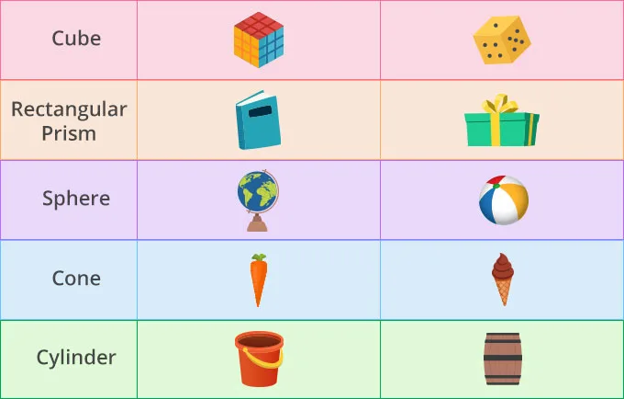 |
Here’s a list of the 3-D, or three-dimensional shapes, with their names, pictures and attributes.
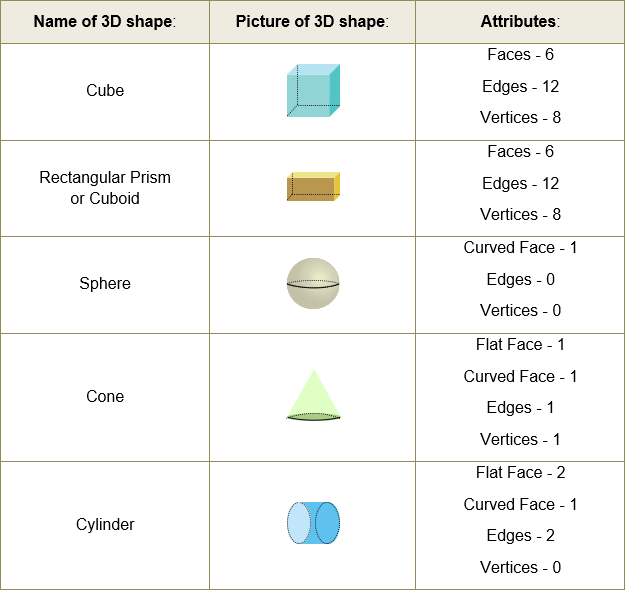 |
Cross-sections of Three-dimensional Figures
A cross section is:
The shape of the cross section depends on the type of "cut" (vertical, angled, or horizontal). The cut can be parallel to the base (a horizontal cut), perpendicular to the base (a vertical cut), or it can be an angled cut.
Basic cross-sections can be polygons or circles.
Types of Cross-sections:
If a shape is cut parallel to the base, the cross section looks just like the base. (Think of a stack of cheese or a stack of books.)
If a shape is cut perpendicular to the base, then the cross section looks just like the lateral face.
If the shape is cut diagonally, the cross section looks like a stretched form of the base.
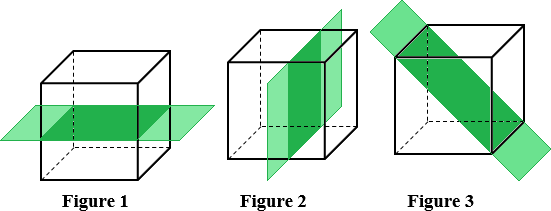 |
Figure 1 shows the cross section of a right, rectangular prism parallel to its base. The cross section is a rectangle.
The cross section of any right prism parallel to its base is congruent to the base.
Figure 2 shows the cross section of a right, rectangular prism perpendicular to its base. The cross section is a rectangle.
Figure 3 shows the cross section of a right, rectangular prism along its diagonal. The cross section is a rectangle.
 |
Figure 4 shows the cross section of a right, rectangular pyramid parallel to its base. The cross section is a rectangle.
Figure 5 shows the cross section of a right, rectangular pyramid through its apex and is perpendicular to its base. The cross section is a triangle.
Figure 6 shows the cross section of a right, rectangular pyramid perpendicular to its base, not through the apex. The cross section is a trapezoid.
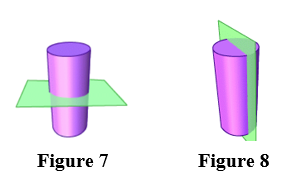 |
Figure 7 shows the cross section of a cylinder diagonal to its base. The cross section is a circle.
Figure 8 shows the cross section of a cylinder perpendicularly. The cross section is a rectangle.
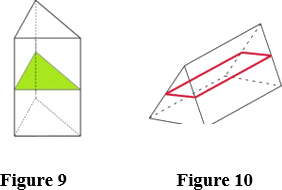 |
Figure 9 shows the cross section of a triangular prism parallel to its base. The cross section is a triangle.
Figure 10 shows the cross section of a triangular prism perpendicular to its lateral face. The cross section is a rectangle.
 |
Figure 11 shows the cross section of a cone perpendicular to its base. The cross section is a triangle.
Figure 12 shows the cross section of a cone parallel to its base. The cross section is a circle.
Figure 13 shows the cross section of a sphere. The cross section is a circle.
Figure 14 shows the cross section of a cone diagonal to its base. The cross section is an ellipse.
|
|
|
|
|
|